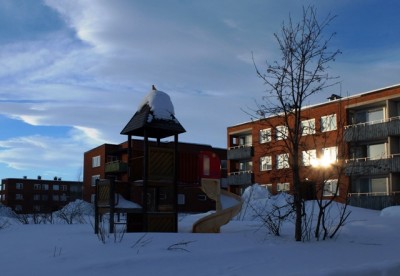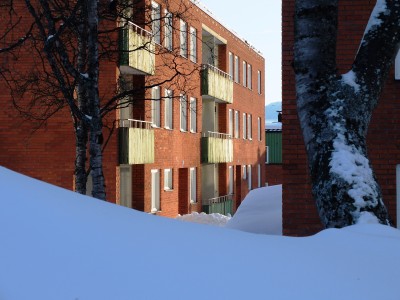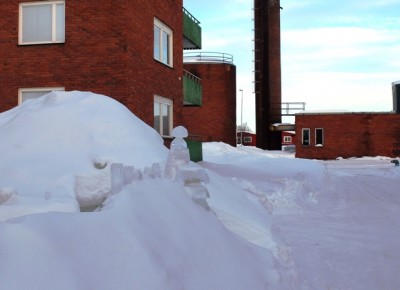We’ve been living in the shadow of the threat of the town moving for years now – we’ve been waiting, watching, and waiting. It feels like nothing much has happened.
Yesterday I took a walk to some blocks of flats spread out in a line along the main road, almost at the foot of town, looking out to the mine and inward to small rectangular play areas. Built as part of Sweden’s ‘A million homes’ programme in the late 1960s, they’re owned by the mining company and have by all accounts provided very comfortable homes for many families over the years. Photographs of the area show children playing outside the flats, with the backdrop of a wide open landscape, leading down and out to the horizon, and the imposing sight of Kirunavaara, the mountain become a mine.
We’ve known these would be the first buildings to go, but the snail’s pace of the town moving process, and the recent fall in iron ore prices (and the mine deciding that perhaps they weren’t in such a tearing rush after all) has lulled us into a feeling it might not even happen in our lifetimes.
The area around these flats (known as ‘Ullspiran’) was marked out at an early stage as part of a (so-called) ‘moving oasis’, where buildings would be emptied, demolished, and the land left as a park. Because they’ve long been earmarked for demolition there’s been a succession of short term tenants living there. I hadn’t even noticed they’d moved out, and now, suddenly, it’s a ghost town. You could hear the metaphorical saloon door swinging in the wind.
It was just a small advertisement in this week’s freebie newspaper, so insignificant-looking you could have missed it. An announcement by the mining company that demolition work in Bromsgatan would start on Monday.
It’s a jolt to realise it’s really happening: the start of the process that will see Kiruna town come tumbling down. I had to go and have a long last lingering look.

I was expecting to find the roads blocked with snow but there had been some kind of activity there so it was still possible to push my kick sled down to the flats, manoeuvring it around the rectangle playgrounds that the buildings all face.
I was expecting to find neglect, desolation, poverty even – but this is Kiruna, so the flats looked in really good condition. It’s hard to accept that such sturdy buildings really need to be knocked down. Through windows I could see smart venetian blinds, good quality shelving, modern light fittings. The balconies still looked inviting in the sunshine.
How long had they been empty, I wondered, and aren’t they rather inviting for anyone without a home, or for groups of disaffected youth (if Kiruna has any)? I found a door lock broken, and was nervous about pushing my way in. I had an irrational fear that the door might slam shut and no-one find me, until much later when someone would notice an arm sticking out from deep within the rubble. The thought kept me on the right side of the doorway.

A little further away, in a square not due for demolition for a few more weeks, I found evidence of people still living here. Someone’s personal belongings lined up on a curtain-draped window – a vase of artificial flowers, a clock and useful blue and white striped jug. The path to the front door had been kept free of snow, and a snow shovel was leaning against the doorway. I couldn’t imagine what it must be like living here. Eerie, I guess – as much because of knowing everything will soon disappear, as because it’s so very very quiet.
Outside this block of flats someone, or some child, has carved out an exquisite igloo, complete with a curving discrete entrance, ice carving decorations, and light vents on all sides. That small home won’t last forever either. Life on the edge is not without its creative side apparently.


